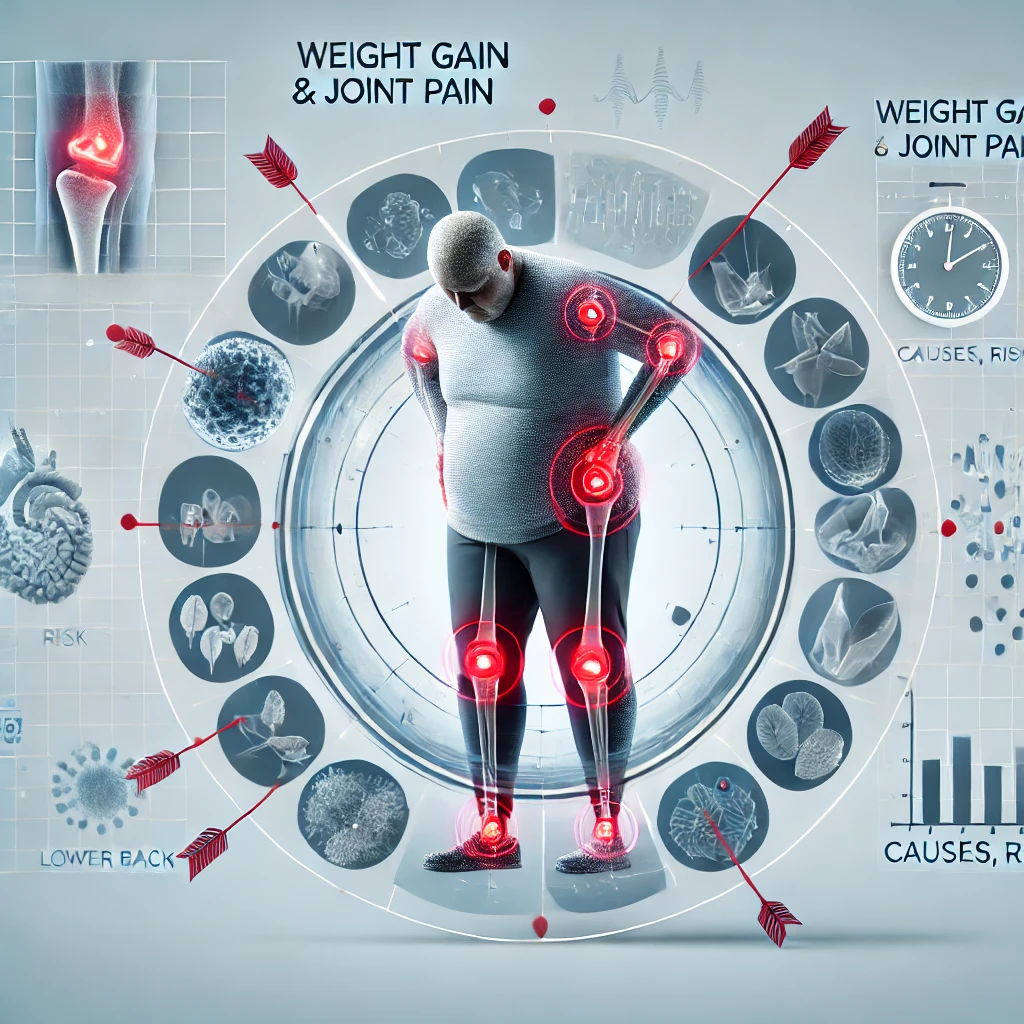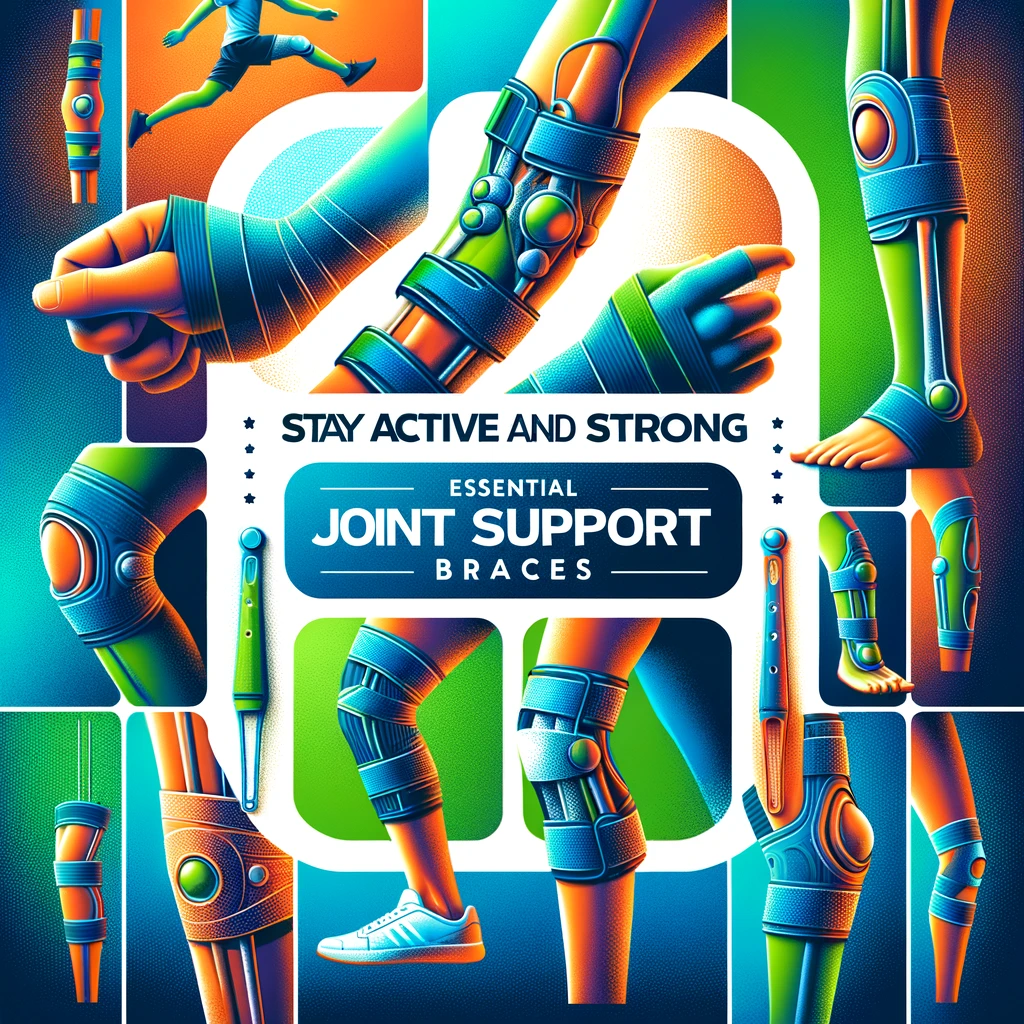
Table of Contents
In the United States, joint pain is one of the most common health complaints among adults having excess body weight. Excess body weight can significantly impact joint health, particularly in weight-bearing joints like the knees, hips, and lower back. Studies show that each additional pound of body mass places extra pressure on these joints, often leading to pain, reduced mobility, and a heightened risk of developing conditions like osteoarthritis.
Understanding the connection between excess body mass and joint soreness can help individuals take proactive steps to protect their joint health. This article will explore the ways in which excess weight affects the joints, the risks associated with obesity and joint distress, and effective relief strategies to support a pain-free, active lifestyle.
The Link Between Weight Gain and Joint Pain
Why Excess Weight Strains the Joints
Increase in body mass places increased stress on weight-bearing joints. For instance, every additional pound of body weight can exert around four extra pounds of pressure on the knees. This means that an individual who gains just 10 pounds is effectively adding 40 pounds of force to their knee joints, significantly accelerating joint wear and tear.
Over time, this additional strain can weaken the cartilage in joints, which serves as a cushion that absorbs shock and enables smooth joint movement. As cartilage wears down, bones begin to rub against each other, causing pain, inflammation, and sometimes leading to arthritis.
The Role of Inflammation in Joint Pain
Excess fat tissue, especially around the abdomen, is associated with increased inflammation in the body. Fat cells release chemicals called cytokines, which can cause chronic inflammation. This inflammation doesn’t just affect body fat but can also damage joint tissue, exacerbating joint pain and making conditions like osteoarthritis more severe.
In particular, individuals who are overweight or obese are often at a greater risk for osteoarthritis in the knees, hips, and lower back. Obesity-related inflammation is a significant factor that contributes to the development and progression of this joint condition.
Which Joints Are Most Affected by Weight Gain
Weight gain predominantly affects weight-bearing joints, such as:
- Knees: The knees are highly susceptible to wear and tear due to excess BMI, leading to chronic pain and increased risk of arthritis.
- Hips: As load-bearing joints, the hips are also impacted by extra weight, often resulting in stiffness, pain, and even a reduced range of motion.
- Lower Back: The spine bears much of the body’s weight, and excess pounds can cause alignment issues, muscle strain, and lower back pain.
By recognizing which joints are most at risk, individuals can take specific steps to protect these areas from further strain and damage.
The Risks of Joint Pain and Weight Gain for U.S. Adults
Increased Risk of Osteoarthritis
Osteoarthritis (OA) is a major cause of disability among adults in the United States of America, and weight gain is a significant contributing factor. When excess weight exerts constant pressure on the joints, it accelerates cartilage breakdown, resulting in OA. Research shows that overweight adults are at a higher risk for knee and hip osteoarthritis, and even modest weight gain can significantly increase this risk.
Mobility and Lifestyle Limitations
Joint pain resulting from weight gain can make daily activities, such as walking, bending, or even climbing stairs, challenging. This pain often discourages physical activity, which can further exacerbate weight gain. This cycle of pain and inactivity creates a feedback loop, where limited mobility leads to additional weight gain, which in turn worsens joint pain.
Impact on Mental Health
Chronic joint pain, especially when compounded by weight issues, can have a considerable effect on mental health. Studies suggest that chronic pain can lead to conditions such as anxiety and depression, creating a burden on overall quality of life. Addressing joint pain effectively can, therefore, improve not only physical well-being but also mental health.
Top 5 Joint Pain Relief Tips for Americans: Managing Weight
Adopt a Balanced Diet for Joint Health
Diet plays a critical role in weight management and joint health. For individuals experiencing joint inflammation due to excess of body fat, a diet rich in anti-inflammatory foods can help alleviate pain. Consider incorporating foods like:
- Omega-3 Fatty Acids: Found in fish such as salmon, these fats reduce inflammation and help maintain joint lubrication.
- Leafy Greens and Berries: These are high in antioxidants, which protect joint tissue from damage.
- Whole Grains: Avoid processed grains and opt for whole grains like oats and brown rice, which help manage weight and support a healthy metabolism.
Reducing the intake of sugar, refined carbs, and processed foods can also lower inflammation levels, benefiting joint health.
Safe Exercises for Joint Pain Relief
While high-impact activities can worsen joint pain, certain low-impact exercises can improve mobility without adding stress to the joints. Recommended exercises include:
- Walking: A low-impact way to get moving without putting too much strain on the knees.
- Swimming: The buoyancy of water helps support the body’s weight, making movement easier and reducing joint pain.
- Cycling: Riding cycle provides cardiovascular benefits and strengthens leg muscles, which can protect the knee joints.
Strengthening the muscles around joints provides additional support, reducing strain and helping to prevent further joint tenderness.
Weight Loss Tips to Reduce Joint Strain
Losing weight, even as little as 5-10% of body fat, can significantly reduce joint pain and improve overall health. Tips for weight loss include:
- Set Realistic Goals: Aim for gradual weight loss to avoid stressing your body.
- Monitor Portion Sizes: Overeating can lead to unnecessary weight gain; keeping portions controlled can help.
- Seek Professional Guidance: A registered dietitian or nutritionist can help design a personalized plan that fits your lifestyle and goals.
Consider Physical Therapy for Long-Term Relief
For those with persistent joint pain, physical therapy can be a valuable solution. Physical therapists can create individualized exercise plans that target specific joints, helping to reduce pain and improve range of motion. Techniques like stretching, range-of-motion exercises, and low-impact strengthening routines are often employed to support joint health.
Incorporate Anti-Inflammatory Supplements
In addition to a balanced diet, anti-inflammatory supplements can help reduce joint pain. Popular options include:
- Turmeric: Contains curcumin, known for its anti-inflammatory properties.
- Glucosamine and Chondroitin: These supplements are commonly used to support cartilage health and alleviate joint discomfort.
- Vitamin D: Essential for bone health, vitamin D can also help reduce inflammation and support joint function.
Conclusion
Weight gain is closely linked to joint pain and can lead to severe complications like osteoarthritis if not addressed. For many U.S. adults, managing weight through diet, exercise, and professional support can significantly reduce joint stiffness and improve mobility. By following a healthy lifestyle that prioritizes joint health, individuals can enjoy an active, pain-free life.
FAQ Section
Can losing weight really reduce joint pain?
Yes, even a modest amount of weight loss can relieve pressure on weight-bearing joints, particularly in the knees and hips, and reduce pain.
What diet is best for managing joint pain?
An anti-inflammatory diet rich in omega-3 fatty acids, antioxidants, and whole grains can help reduce joint inflammation and pain.
What types of exercises are safe for joint discomfort?
Low-impact exercises like swimming, walking, and cycling are generally safe and beneficial for those with joint pain. Strengthening exercises can also help support and protect the joints.
Does weight gain increase the risk of arthritis?
Yes, weight gain, especially in the form of body fat, increases the risk of osteoarthritis by placing more strain on the joints and causing inflammation.
How does weight gain affect mental health in relation to joint pain?
Chronic joint pain due to weight gain can lead to mental health challenges such as anxiety and depression, impacting overall quality of life. Maintaining joint health can support both physical and mental well-being.



